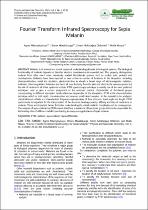JavaScript is disabled for your browser. Some features of this site may not work without it.
- ResearchSpace
- →
- Research Publications/Outputs
- →
- Journal Articles
- →
- View Item
| dc.contributor.author |
Mbonyiryivuze, A

|
|
| dc.contributor.author |
Mwakikunga, Bonex W

|
|
| dc.contributor.author |
Dhlamini, SM

|
|
| dc.contributor.author |
Maaza, M

|
|
| dc.date.accessioned | 2016-06-27T08:41:19Z | |
| dc.date.available | 2016-06-27T08:41:19Z | |
| dc.date.issued | 2015-08 | |
| dc.identifier.citation | Mbonyiryivuze, A. Mwakikunga, B. Dhlamini, S.M. and Maaza, M. 2015. Fourier transform infrared spectroscopy for sepia melanin. Physics and Materials Chemistry, 3(2), 25-29 | en_US |
| dc.identifier.issn | 2372-7098 | |
| dc.identifier.uri | http://pubs.sciepub.com/pmc/3/2/2/ | |
| dc.identifier.uri | http://hdl.handle.net/10204/8587 | |
| dc.description | Copyright: 2015 Science and Education Publishing | en_US |
| dc.description.abstract | Melanin is of interest as a model system of understanding disorder in biological systems. The biological functionality of melanin depends on disorder which is considered as its essential part. This property distinguishes melanin from other much more intensively studied biomolecule systems such as nucleic acid, proteins and carbohydrates. Melanins have been reported to have a diverse number of functions in the biosystem, including photosensitization, metal ion chelation, photoprotection to absorb a broad range of electromagnetic radiation, antibiotic, thermoregulation. Melanins are found all over the body from the skin and blood to the nervous system but the role of melanin in all these system is unclear. FTIR spectroscopy technique is usually one of the most preferred techniques used to give a correct assignment of the observed spectral characteristic of functional groups corresponding to different absorption bands which are responsible of the absorption. FTIR is the characterization technique which is both rapid, non-destructive and requires small sized samples. In the material to be analysed, chemical bonds vibrate at a characteristic frequency representative of their structure, bond angle and length. FTIR spectrometer is important for the interpretation of the structure, binding capacity, affinity and sites of metal ions in melanin. These are important factors for better understanding the metals melanin complexity and its consequences. The analysis of sepia melanin by FTIR reveals that there is existence of functional groups that can be responsible for the binding cites of different metallic ions leading to many new applications of sepia melanin. | en_US |
| dc.language.iso | en | en_US |
| dc.publisher | Science and Education Publishing | en_US |
| dc.relation.ispartofseries | Workflow;16342 | |
| dc.subject | Biological systems | en_US |
| dc.subject | Nucleic acid | en_US |
| dc.subject | Metal ion chelation | en_US |
| dc.subject | Proteins | en_US |
| dc.subject | Carbohydrates | en_US |
| dc.subject | Photoprotection | en_US |
| dc.subject | Chemical bonds | en_US |
| dc.title | Fourier transform infrared spectroscopy for sepia melanin | en_US |
| dc.type | Article | en_US |
| dc.identifier.apacitation | Mbonyiryivuze, A., Mwakikunga, B. W., Dhlamini, S., & Maaza, M. (2015). Fourier transform infrared spectroscopy for sepia melanin. http://hdl.handle.net/10204/8587 | en_ZA |
| dc.identifier.chicagocitation | Mbonyiryivuze, A, Bonex W Mwakikunga, SM Dhlamini, and M Maaza "Fourier transform infrared spectroscopy for sepia melanin." (2015) http://hdl.handle.net/10204/8587 | en_ZA |
| dc.identifier.vancouvercitation | Mbonyiryivuze A, Mwakikunga BW, Dhlamini S, Maaza M. Fourier transform infrared spectroscopy for sepia melanin. 2015; http://hdl.handle.net/10204/8587. | en_ZA |
| dc.identifier.ris | TY - Article AU - Mbonyiryivuze, A AU - Mwakikunga, Bonex W AU - Dhlamini, SM AU - Maaza, M AB - Melanin is of interest as a model system of understanding disorder in biological systems. The biological functionality of melanin depends on disorder which is considered as its essential part. This property distinguishes melanin from other much more intensively studied biomolecule systems such as nucleic acid, proteins and carbohydrates. Melanins have been reported to have a diverse number of functions in the biosystem, including photosensitization, metal ion chelation, photoprotection to absorb a broad range of electromagnetic radiation, antibiotic, thermoregulation. Melanins are found all over the body from the skin and blood to the nervous system but the role of melanin in all these system is unclear. FTIR spectroscopy technique is usually one of the most preferred techniques used to give a correct assignment of the observed spectral characteristic of functional groups corresponding to different absorption bands which are responsible of the absorption. FTIR is the characterization technique which is both rapid, non-destructive and requires small sized samples. In the material to be analysed, chemical bonds vibrate at a characteristic frequency representative of their structure, bond angle and length. FTIR spectrometer is important for the interpretation of the structure, binding capacity, affinity and sites of metal ions in melanin. These are important factors for better understanding the metals melanin complexity and its consequences. The analysis of sepia melanin by FTIR reveals that there is existence of functional groups that can be responsible for the binding cites of different metallic ions leading to many new applications of sepia melanin. DA - 2015-08 DB - ResearchSpace DP - CSIR KW - Biological systems KW - Nucleic acid KW - Metal ion chelation KW - Proteins KW - Carbohydrates KW - Photoprotection KW - Chemical bonds LK - https://researchspace.csir.co.za PY - 2015 SM - 2372-7098 T1 - Fourier transform infrared spectroscopy for sepia melanin TI - Fourier transform infrared spectroscopy for sepia melanin UR - http://hdl.handle.net/10204/8587 ER - | en_ZA |






